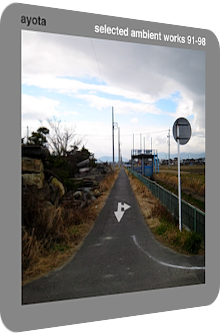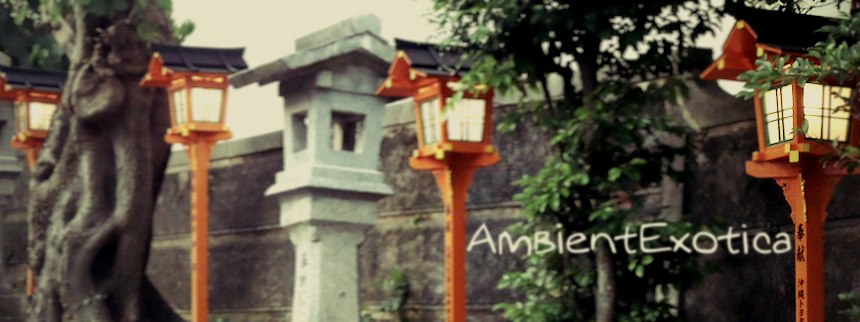
Ayota
Selected Ambient Works 91–98
2007
Selected Ambient Works 91–98 is both the debut album of Dominic Oakenfull's Ayota project and an anthology, released on the artist's own Primaudial Records and comprising of his first never released Ambient vignettes and field recording adventures. While he releases club-compatible stompers under his better known alias Ski Oakenfull, it is the works of his moniker Ayota that truly capture my heart time and again, for they blend distinctly Japanese tone sequences and auras with entrancing synthscapes. Having reviewed both his proper debut album Helicopter Cuts of 2007 and his Sōnen EP of 2011, Selected Ambient Works 91–98 was mostly new to me, but all the more intriguing, as three of Oakenfull's compositions off the Sōnen EP are already featured on this album. And a great one it is, too! It perfectly encapsulates the innocent spirits of the early 90's which were freed from all genre conventions until a certain point.
The material consists of a whopping 19 tracks, most of them purely electronic, others merging acoustic guitars and piano arrangements. From a titular viewpoint, the album of course has much in common with Aphex Twin's Selected Ambient Works 85–92, but it is, in terms of its aesthetics-related concept, in fact much more closely tied to Thomas Fehlmann's Good Fridge, which features (presumably polished) material of the years 1990–98. Ayota's album is the "real deal," so to speak, with unaltered, original mixes of each track. While I cannot possibly review all of the 19 compositions, I am reviewing 16 of them; those that were neglected are not inferior in any way, it is just that I had to further select Ayota's selections in order to not write an overly detailed and interminable review. At time of writing, the album is available on the Primaudial Records website, Yahoo! Music and many other stores, but not on iTunes or Amazon. But regardless of your favorite shop, pre-listen to this album if you are longing for a generous dose filled with 90's nostalgia and multi-colored synth hooks.
The opener Centrair fades in with misty-eyed electric piano chords that are cleverly meshed in-between swelling and falling synth elements. When the main melody launches in the form of a hazy, soothing synth pad, its surrounding ornaments start to rise, get glitzier and louder while everything remains a mellow wash, especially so in contrast to the live version on Ayota’s Sōnen EP where these plinking particles are revved up to the maximum and admixed to an electric guitar. It’s an intriguing song about morning melancholia, and the little places of shelter where one can contemplate while commuting through a bustling megacity. The following Haishya unleashes dusky staccato rotors below a shaker-infused breakbeat complete with synthetic raindrops and thin pads. The obvious showstopper is the five-note theme that is not introduced until we’re almost two and a half minutes in the song. It unites sunset-red textures with a somewhat dubious apocalyptic ethereality, transporting that certain late-80’s feeling. According to the liner notes, there is even a dental surgery sample intermixed, but at least to my ears, it is not audible and most certainly heavily altered anyway. Considering that Haisyha is also featured on the Sōnen EP in a boldly, wonderfully dreamy Japanized version that outclasses the colder, clinically sterile feeling of the original, I tend to believe that both Centrair and Haishya were one of the latest songs created by Oakenfull.
While Redocov marries a blurry, quavering but sizzling-hot synth accompaniment with echoey clicks, silky beats and splendidly incandescent 8-bit chime curlicues, the six and a half minutes long Static Travel inherits the timbre of Redocov and weaves it into a municipal five-note melody with several half-tone steps, a steady 4/4 beat and majestical synth washes as the song progresses. And yes, you’ve read that right: I wrote municipal in order to stress the electrifying energy of this otherwise balmy Ambient-Dance hybrid, as it implies neon-lit cities full of architectural prowess. I might be totally off track here, but it is the attached nostalgia of these electronic pieces and the innocence, even skillfully purposeful artlessness – i.e. the clear focus – that altogether make these tunes successful artifacts of the early to mid 90’s when today’s genre conventions were not yet established. Static Travel is pure bliss and a great enhancement of my running playlist.
Kokyu introduces a decisive amount of mystique to the album. A blue-tinted wave-like eight-tone loop meanders through breakbeat-driven phases, liquedous harp-like twangs, positively quirky synth crystal shards and muffled shakers. Not much changes through the course of the composition, and rightfully so, as most of the elements are established in the first minute already and inject warmth in an otherwise mild-mannered setting with a scent of coldness. Mike Over The Bar starts with cherubic synth streams, includes an Italo House piano and puts delicately exotic percussion into the limelight, with a thin melody wafting in the background adjacent to accentuating dubby bass lines. The danger of becoming a silly Lounge track is ruled out, as there is no pumping beat and the atmosphere is very dense and clean-handed.
One particular tune must not be left unmentioned: Forking Out is a gorgeously melodious and straightforward Pop song, with downwards spiraling synth molecules, warm bass lines, an acoustic guitar infusion delivered by Rick Fraser, and the magnanimous use of the phaser which lets the cymbals and percussion permeate through the saccharine softness. I am usually wary of acoustic guitars in Ambient songs – and to be honest, this is actually not a proper Ambient song – but the joy and carelessness are appealing and form a great counterpart to the otherwise hyper-electronic outings of Selected Ambient Works 91–98. The next tune, Concorde 512, is a conclusive piano arrangement with repeated waves of synth strings and a transcending crystalline opalescence. It is a solemn, transfiguring composition full of happiness and blitheness, hence remaining close to the guitar formula of Forking Out without being overly syrupy. That Dominic Oakenfull is able to create serious piano arrangements has been proven by him for the first time on this album, and this style is the base of many later tunes, probably most distinctly on 日溜り(Hidamari) off his actual debut album as Ayota, Helicopter Cuts.
The latter half of the album has written change and diversion all over it, though it remains in clear-cut electronic territories, with a gargantuan stomper called Sonen unleashed next. This is the track that gave the later Sōnen EP its name, and over the months and years I’ve listened to its Re-Edit of this EP, I truly fell in love with the exuberantly happy vibe of felicity and good fortune. The original incarnation as featured on Selected Ambient Works 91–98 launches with a pulsating bass drone, waves of static noise, warm synth capsules and a fade-in of the pumping club-compatible 4/4 beats. The synth pads are perfectly gleaming and utterly warm, and the complemental synth washes augment the feeling of resplendent rapture. The perfect song for running! In contrast to the 2011 Re-Edit, the bass line is a bit softer, the zipper-like acid elements are more on the foreground, and both the introduction and closing phase differ from it. Especially the latter is great on this original, with a spectral Doppler effect being applied to icy synth creeks. It’s a huge track in any incarnation and one of my essentials.
While Sea Beams paints a retro-futuristic cyberspace in the veins of Lone or Stellar OM Source with aqueously phased synths, staccato percussion, muffled vocal sections and a mood that is best described as shuffling between coldness and beauty, the following suite of five tracks called Sun Salutation is described as Ayota’s earliest experiments and can thus be placed in-between the years of 1991 and 92, I suppose. But make no mistake, as these five vignettes conflate the Japanese flavor with a lachrymose superimposition. Sun Salutation 1 meshes sun-warmed pads with Far Eastern synth droplets and increases the peacefulness with its constant interplay between sound, sustain and space, giving each element enough room to glimmer and shine. And melodious it is, too! Sun Salutation 2 adds an ecclesial setting and turns up the heat, with a four-note synth pad melody and positively warped waves of balm washing over the listener. The blurry shakers give the impression of being right back in a bolstered uterus: everything is muffled and analogue-sounding, but so cozy and snugly. Sun Salutation 3 adds liminal scents of peril to the scene, as the synth washes are much colder and the related stabs a tad more aggressive. The three-minute arrangement Sun Salutation 4 remains in this clime but adds wonderfully hollow bongos and bass melodies to its ambience. Since the three and a half minutes long centerpiece Sun Salutation 5 ends the suite by meshing enigmatically pulsating synth gusts with a decided breakbeat groove that’s taken right from the 80’s, it is time for the final Wink, a probably overly long and ever-changing lead-out jam session full of muffled guitars played by Nemo Jones and Rob Fairweather, gentle static and pink noise particles as well as a field recording of a playground. It is the most experimental tune and a last contrastive device to the utterly focused 18 tracks that came before it.
Selected Ambient Works 91–98 provides a fantastic journey to long-gone times, whether you are a fan of Dominic Oakenfull's Ayota alias and know a few of the included offerings already, or you are generally interested in Ambient music with Japanese scents. The Far Eastern tonality is surprisingly low-key here, almost camouflaged and swallowed by the gorgeous Occidental synth riffs and percussive patterns. In this specific regard, Ayota's full-length debut Helicopter Cuts and the Sōnen EP provide bolder Asian tone sequences. Apart from this assertion, the album succeeds with its tremendously catchy and hummable main melodies, the carved-out accentuations, the many synth stabs and occasional guitar fragments. The mood is at times doleful and mystical, but the synthscapes are mostly exuberantly joyful and saturated.
Naming a favorite tune is almost impossible, but I can stress my relief about the variety of rhythms, as pristine beatless Ambient tracks are as important as Breakbeat or Dance-related material; especially Static Travel and Sonen are luxurious, melodious and essential gems, with Sea Beams and Haishya reaching close second places. They are all suitable for running or jogging, and again, it is their retro charm that makes them work so well. Some people would deny these tunes the Ambient quality seal, but I do not see a problem with that, as the background ambience is always perceptible even in the most overexposed beat settings. Selected Ambient Works 91–98 is a wonderful lucky bag, and the fact that these rarities were never released before is beyond me. Oakenfull is way too humble in this regard, he could distribute this self-released gemstone in a much larger way, as he owns the rights to all of his tunes. If you insist on the melodious, dynamic kind of Ambient music that was created in a time when subgenres like Drone or Glitch were about to appear, but nowhere to be found on the album, then I wholeheartedly recommend this album, whether you are expecting a trip down memory lane to the salad days of early Rave after-hours or a mystified, becalming atmosphere. Everything is in there… and so much more.
Further reading and listening:
- You can listen to samples of Selected Ambient Works 91–98 on the Primaudial Records website.
- Follow Dominic Oakenfull on Twitter: @skioakenfull.
Ambient Review 130: Ayota – Selected Ambient Works 91–98 (2007). Originally published on Oct. 3, 2012 at AmbientExotica.com.
